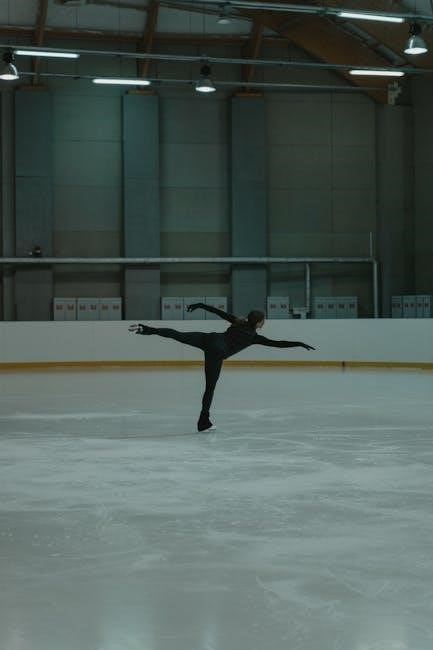Anterior Pelvic Tilt (APT) is a common postural imbalance where the pelvis tilts forward, increasing the natural curve of the lower back. It often leads to musculoskeletal discomfort, such as lower back pain and hip tightness, impacting daily activities and athletic performance. Addressing APT through targeted exercises is essential for restoring proper alignment, enhancing mobility, and preventing long-term complications. This guide provides a comprehensive approach to understanding and correcting APT, offering practical solutions for improved posture and overall musculoskeletal health.
What is Anterior Pelvic Tilt?
Anterior Pelvic Tilt (APT) is a postural imbalance where the front of the pelvis tilts forward, causing an exaggerated inward curve of the lower back, known as lumbar lordosis. This condition occurs when the hip flexors and lower back muscles become overly tight, while the abdominal and gluteal muscles weaken. APT is often described as a “lower crossed syndrome,” where the pelvis shifts out of its neutral alignment. It can result from prolonged sitting, poor posture, or muscle imbalances. If left unaddressed, APT may lead to discomfort, reduced mobility, and even long-term musculoskeletal issues. Understanding this condition is the first step toward implementing corrective exercises to restore proper pelvic alignment and improve overall posture. Regular engagement in targeted exercises can help alleviate symptoms and promote a balanced, healthy pelvic position.
Causes and Symptoms of Anterior Pelvic Tilt
Anterior Pelvic Tilt (APT) arises from muscle imbalances, where tight hip flexors and lower back muscles pull the pelvis forward, while weak abdominals and glutes fail to counteract this movement. Common causes include prolonged sitting, sedentary lifestyles, and poor posture habits. Symptoms often manifest as lower back pain, hip discomfort, and a noticeable protrusion of the abdomen. In severe cases, APT can lead to altered gait patterns and increased strain on the knees and hips. Early identification of these symptoms is crucial for preventing long-term musculoskeletal issues. Addressing APT through targeted exercises can alleviate discomfort and restore proper pelvic alignment, thereby improving overall posture and reducing the risk of further complications.

Importance of Exercises in Correcting Anterior Pelvic Tilt
Targeted exercises are crucial for addressing APT by correcting muscle imbalances, strengthening weak muscles, and improving posture. Regular routines prevent complications and promote long-term musculoskeletal health effectively.
How Exercises Address Muscular Imbalances
Exercises for anterior pelvic tilt focus on correcting muscle imbalances by strengthening weak muscles and stretching tight ones. Weak glutes and abdominals often contribute to APT, while tight hip flexors pull the pelvis forward. Specific routines like glute bridges and planks target these areas, improving muscle function and alignment. Stretching exercises, such as hip flexor and hamstring stretches, alleviate tightness, reducing the forward pull on the pelvis. By addressing these imbalances, exercises help restore a neutral pelvic position, enhancing posture and reducing discomfort. Consistent practice ensures long-term correction and prevents recurrence, promoting overall musculoskeletal health and improving daily activities. This balanced approach is essential for effective APT correction.
Benefits of a Structured Exercise Routine
A structured exercise routine offers numerous benefits for correcting anterior pelvic tilt. It ensures consistency and progression, helping to address muscle imbalances effectively. A well-designed program provides clear guidance, making it easier to follow and maintain. By incorporating strengthening and stretching exercises, individuals can improve posture, reduce pain, and enhance mobility. Structured routines also promote accountability, encouraging regular practice and long-term commitment. Additionally, having a downloadable PDF guide allows for accessibility, enabling users to perform exercises anywhere. The combination of visual aids, step-by-step instructions, and progressive challenges ensures a comprehensive approach to correcting APT. This structured method supports overall musculoskeletal health and empowers individuals to take control of their posture and well-being.

Key Exercises for Correcting Anterior Pelvic Tilt
Posterior pelvic tilts, glute bridges, and hip thrusts strengthen glutes and improve alignment. Planks enhance core stability, while stretching hip flexors and hamstrings reduces tightness.
Posterior Pelvic Tilt Exercises
Posterior pelvic tilt exercises are foundational for correcting anterior pelvic tilt. These exercises involve tilting the pelvis backward to flatten the lower back and engage the core. Lying pelvic tilts, where you tilt your pelvis while lying on your back, are a great starting point. Standing pelvic tilts can also be effective, promoting awareness of proper pelvic alignment. These movements strengthen the posterior muscles, such as the abdominals and hamstrings, while stretching tight hip flexors. Regular practice helps restore a neutral pelvic position, improving posture and reducing discomfort. Incorporating these exercises into a daily routine can lead to significant improvements in pelvic alignment and overall musculoskeletal health. Consistency is key to achieving long-term benefits.
Glute Bridges and Hip Thrusts
Glute bridges and hip thrusts are essential exercises for addressing anterior pelvic tilt by strengthening the gluteal muscles. These movements target the glutes, which are often weak in individuals with APT. By performing glute bridges, you engage the gluteus maximus, helping to pull the pelvis into a more neutral position. Hip thrusts, whether bodyweight or weighted, further enhance glute strength and promote proper pelvic alignment. These exercises not only improve posture but also enhance athletic performance and reduce the risk of lower back pain. Incorporating them into your routine can lead to stronger, more balanced glutes, which are crucial for correcting and preventing APT. Consistent practice ensures optimal results and long-term musculoskeletal health.
Planks and Core Strengthening
Planks and core strengthening exercises are vital for addressing anterior pelvic tilt by improving pelvic stability and overall core engagement. These exercises target the transverse abdominis and obliques, which play a crucial role in maintaining a neutral pelvic position. Strengthening the core helps counteract the forward tilt of the pelvis, reducing the strain on the lower back. Incorporating variations like the RKC plank can further enhance pelvic floor activation and stability. Regular practice of these exercises promotes better posture, reduces discomfort, and supports long-term correction of APT. By stabilizing the pelvis and strengthening the core, planks contribute significantly to restoring proper pelvic alignment and improving musculoskeletal health. Consistent engagement in these exercises is essential for achieving optimal results and preventing future imbalances.
Stretching the Hip Flexors and Hamstrings
Stretching the hip flexors and hamstrings is a crucial component of correcting anterior pelvic tilt, as tightness in these muscles can pull the pelvis into an imbalanced position. The hip flexors, particularly the iliopsoas, often become overactive and tight, contributing to the forward tilt of the pelvis. Similarly, the hamstrings may also become tight, further exacerbating the issue. Stretching these muscle groups helps to reduce tension, allowing the pelvis to return to a more neutral alignment. Exercises like the standing hip flexor stretch, seated hamstring stretch, and couch stretch are effective in targeting these areas. Regular stretching not only improves flexibility but also supports the effectiveness of strengthening exercises, promoting a balanced approach to correcting APT and enhancing overall mobility. Incorporating these stretches into a daily routine can significantly aid in restoring proper pelvic alignment.

Creating an Effective Anterior Pelvic Tilt Exercise PDF Guide
A well-designed PDF guide should prioritize clarity and accessibility, featuring detailed exercise instructions, visual aids, and a structured routine. This ensures ease of use for both professionals and patients.
Designing the PDF for Clarity and Accessibility
Designing a PDF guide for anterior pelvic tilt exercises requires a focus on clarity and accessibility. The layout should be clean, with clear headings and subheadings to guide users through the content. High-quality images and diagrams are essential for illustrating exercises, ensuring that readers can visualize and replicate the movements accurately. The text should be concise, using bullet points and short paragraphs to enhance readability. Accessibility features, such as adjustable font sizes and proper color contrast, make the guide usable for individuals with visual impairments. Organizing the exercises into categorized sections, like warm-ups, strengthening routines, and stretches, helps users navigate the document effortlessly. Including downloadable options ensures the guide is portable and can be accessed on various devices, making it a versatile resource for both home use and clinical settings.
Including Visual Aids and Instructions
Including high-quality visual aids and detailed instructions in the PDF is crucial for ensuring users can understand and perform the exercises correctly. Images and diagrams should clearly illustrate proper posture, muscle engagement, and movement techniques. Step-by-step instructions, broken down into simple, actionable points, help users follow along without confusion. Using bullet points and short paragraphs enhances readability, while video links provide real-time demonstrations for complex exercises. Visual cues, such as arrows or highlighted muscle groups, can emphasize key movements. Clear instructions also address common mistakes, ensuring safety and effectiveness. By combining written descriptions with visual elements, the guide becomes a comprehensive and user-friendly resource for correcting anterior pelvic tilt. This approach caters to different learning styles, making the exercises accessible to everyone.

Preventative Measures and Maintenance
Regular strengthening of core and glute muscles, maintaining proper posture, and incorporating stretching into daily routines help prevent anterior pelvic tilt and promote long-term spinal health and stability.
Strengthening Core and Glute Muscles
Strengthening the core and glute muscles is essential for correcting anterior pelvic tilt. Weak glutes and tight hip flexors often contribute to the condition, as they pull the pelvis forward. Exercises like glute bridges, hip thrusts, and planks target these muscle groups, helping to restore balance and stability. By engaging in regular core-strengthening activities, individuals can improve pelvic alignment and reduce the risk of related pain or discomfort. Consistency is key, as muscle imbalances that lead to APT develop over time. Incorporating these exercises into a daily routine promotes long-term postural improvement and prevents recurrence. A strong core and glutes provide the foundation for proper pelvic positioning, making these exercises a critical component of any APT correction plan.
Maintaining Proper Posture
Maintaining proper posture is crucial for addressing anterior pelvic tilt and preventing its progression. When standing, sitting, or exercising, keeping a neutral spine and pelvis helps counteract the forward tilt. Awareness of body positioning throughout the day is vital, as prolonged sitting or slouching can exacerbate the condition. Incorporating posture-correcting exercises, such as wall angels and pelvic tilts, reinforces proper alignment. Additionally, mindfulness practices like setting reminders to adjust posture can foster long-term habits. By prioritizing proper posture, individuals can reduce muscle imbalances, alleviate discomfort, and promote a healthier pelvic alignment. Consistent effort in maintaining good posture complements exercise routines, ensuring a comprehensive approach to correcting anterior pelvic tilt and enhancing overall musculoskeletal well-being.
Regular Stretching and Mobility Work
Regular stretching and mobility work are essential for addressing anterior pelvic tilt by targeting tight muscle groups that pull the pelvis out of alignment. Focusing on the hip flexors, hamstrings, and lower back muscles can help reduce stiffness and improve flexibility. Dynamic stretches, such as hip circles and leg swings, enhance mobility and promote proper pelvic movement. Incorporating these stretches into a daily routine ensures consistent progress and prevents the recurrence of imbalances. Additionally, foam rolling the hip flexors and quads can release tension, further supporting pelvic alignment. By prioritizing regular stretching, individuals can maintain musculoskeletal health, enhance posture, and reduce the risk of discomfort associated with anterior pelvic tilt. Consistency is key to achieving long-term benefits and overall pelvic stability.

Case Studies and Success Stories
Real-life examples highlight individuals achieving significant improvement in posture and pain reduction through targeted APT exercises. Testimonials from healthcare professionals endorse these routines for long-term musculoskeletal health.
Real-Life Examples of Exercise Success
Individuals with anterior pelvic tilt have reported significant improvements after following structured exercise routines. For instance, a 35-year-old office worker reduced lower back pain by incorporating glute bridges and hip thrusts into her daily routine. Another case involved a young athlete who enhanced his performance by strengthening his core and improving pelvic alignment. These success stories demonstrate how consistent exercise can restore proper posture and alleviate discomfort, showcasing the effectiveness of targeted routines in real-world applications.
Testimonials from Healthcare Professionals
Healthcare professionals highly recommend anterior pelvic tilt exercises for their effectiveness in correcting postural imbalances. Dr. Shaina, a physical therapist, notes that “targeted exercises like glute bridges and planks have significantly improved patient outcomes, reducing lower back pain and enhancing mobility.” Similarly, chiropractors emphasize the importance of structured routines, stating that “consistent practice of pelvic tilts and core strengthening exercises leads to sustained postural correction.” These testimonials underscore the value of evidence-based exercise plans in rehabilitation, supported by clinical insights and patient success stories.
Summarizing the Exercise Plan
The anterior pelvic tilt exercise plan focuses on addressing muscle imbalances through strengthening and stretching. Key exercises include posterior pelvic tilts, glute bridges, planks, and hip flexor stretches. These exercises target weak muscles like the glutes and abdominals while relieving tightness in the hip flexors and hamstrings. The routine is structured to improve posture, reduce pain, and restore proper pelvic alignment. Consistency is crucial, with sessions lasting 25-35 minutes, ideally 3-4 times a week. Progression and proper form are emphasized to ensure effectiveness and prevent injury. By following this plan, individuals can achieve a neutral pelvic position, alleviate discomfort, and enhance overall musculoskeletal function.
Encouraging Consistency and Patience
Consistency and patience are vital when addressing anterior pelvic tilt, as correction is a gradual process. Developing improper posture and muscle imbalances often takes years, so reversing them requires time and dedication. Regular practice of the exercises, even for a few minutes daily, can lead to noticeable improvements over time. It’s important to stay motivated by celebrating small progress, such as better posture or reduced discomfort. Patience is key, as the body needs time to adapt and strengthen. By committing to the exercise plan and maintaining a positive mindset, individuals can achieve lasting results and improve their overall musculoskeletal health. Remember, consistency breeds habit, and patience fuels progress.

Appendix
The appendix provides additional resources, including exercise diagrams, scientific references, and a comprehensive bibliography, to support the correction of anterior pelvic tilt effectively. Use these tools to enhance understanding and application of the exercises.
Additional Resources and References
For further learning, explore these resources:
– Books: “Pelvic Power” by Dr. Shaina and “Corrective Exercise for Anterior Pelvic Tilt.”
– Scientific Articles: Studies in Manual Therapy and EFORT Open Reviews on APT rehabilitation.
– Websites: Forethoughtmed offers detailed guides and exercise plans.
– PDF Guides: Downloadable plans like “Anterior Pelvic Tilt Rehab Plan” for structured routines.
– Professional Consultations: Engage with physical therapists for personalized advice.
These resources provide in-depth insights, exercises, and expert recommendations for correcting APT effectively. Always consult healthcare professionals before starting new routines.
